BSc (Hons) Business Management: Applied Business Finance Report
VerifiedAdded on 2023/06/05
|11
|2925
|188
Report
AI Summary
This report, submitted as part of a BSc (Hons) Business Management program, delves into the core concepts of financial management, emphasizing its significance in business operations. It begins with a definition and discussion of financial management, highlighting its role in resource allocation and enhancing return on investment. The report then describes the main financial statements, including the balance sheet, profit and loss account, and cash flow statement, and explains the application of ratio analysis to assess profitability, liquidity, and efficiency. A significant portion of the report is dedicated to a case study analysis, where the provided template is used to complete a business review, produce income statements and balance sheets using Excel, and interpret the company's financial performance based on ratio analysis results. The report concludes by suggesting strategies the business can use to improve its financial performance, such as expanding the customer base, considering investments, and updating offers and prices.
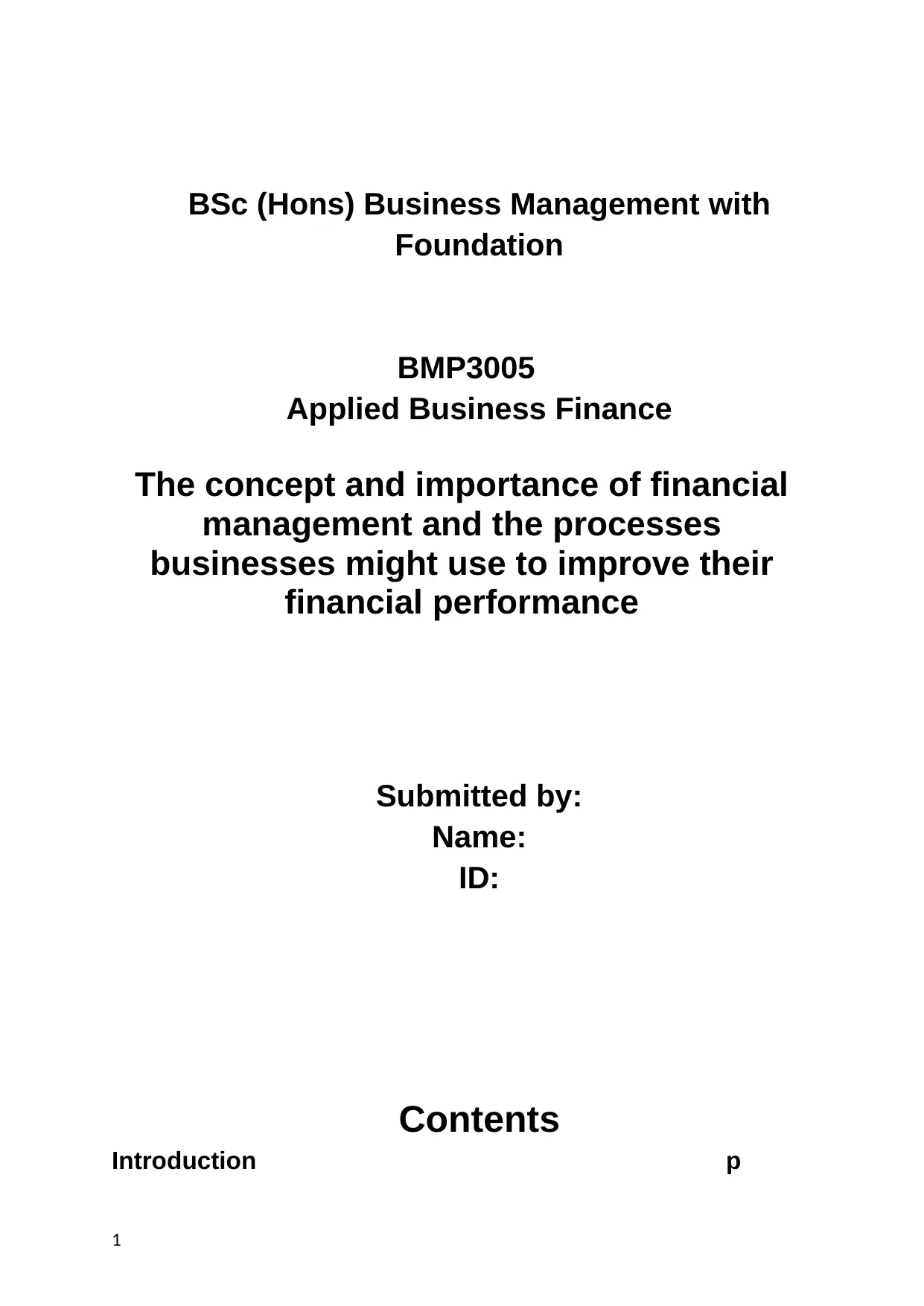
BSc (Hons) Business Management with
Foundation
BMP3005
Applied Business Finance
The concept and importance of financial
management and the processes
businesses might use to improve their
financial performance
Submitted by:
Name:
ID:
Contents
Introduction p
1
Foundation
BMP3005
Applied Business Finance
The concept and importance of financial
management and the processes
businesses might use to improve their
financial performance
Submitted by:
Name:
ID:
Contents
Introduction p
1
Paraphrase This Document
Need a fresh take? Get an instant paraphrase of this document with our AI Paraphraser
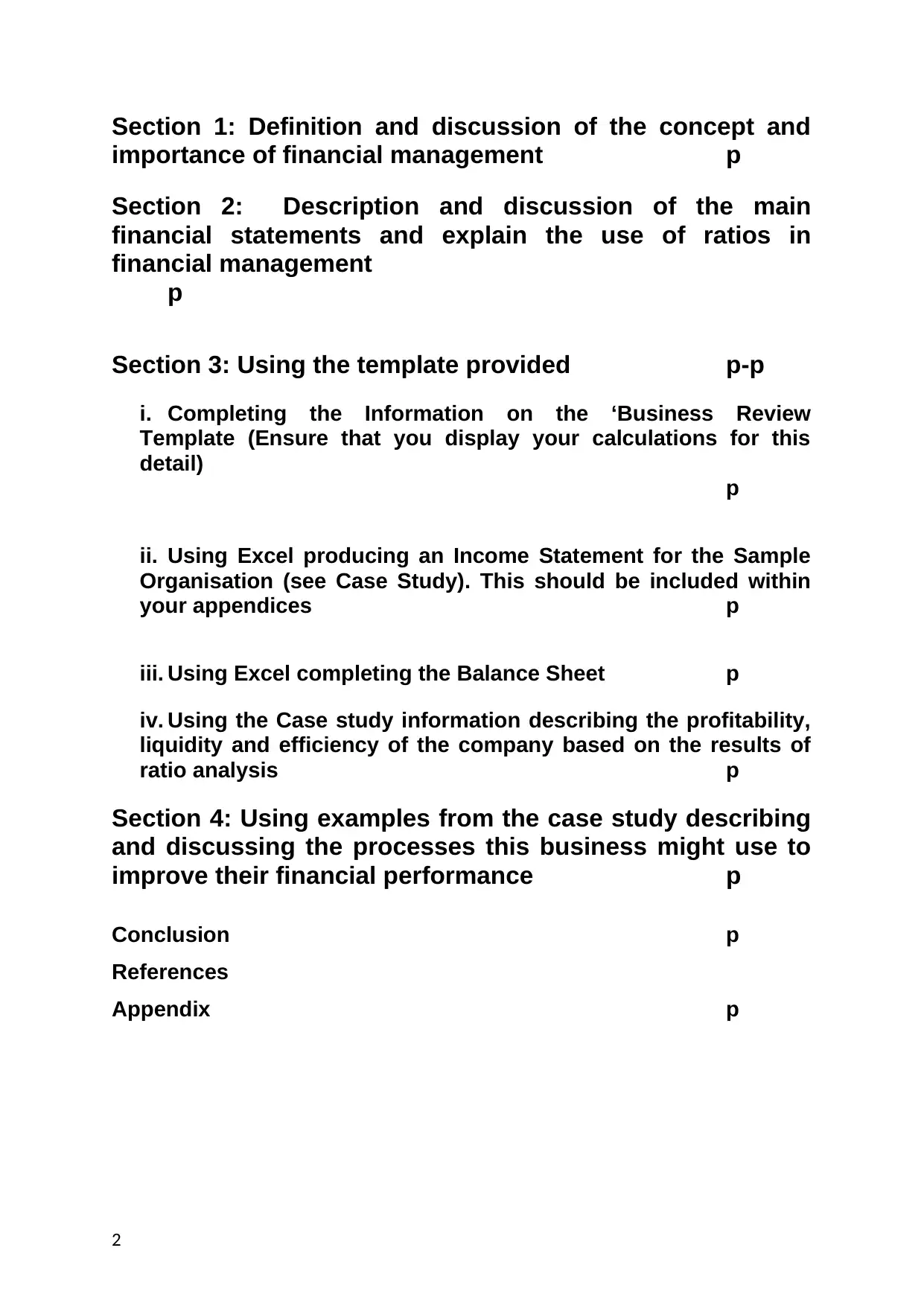
Section 1: Definition and discussion of the concept and
importance of financial management p
Section 2: Description and discussion of the main
financial statements and explain the use of ratios in
financial management
p
Section 3: Using the template provided p-p
i. Completing the Information on the ‘Business Review
Template (Ensure that you display your calculations for this
detail)
p
ii. Using Excel producing an Income Statement for the Sample
Organisation (see Case Study). This should be included within
your appendices p
iii. Using Excel completing the Balance Sheet p
iv. Using the Case study information describing the profitability,
liquidity and efficiency of the company based on the results of
ratio analysis p
Section 4: Using examples from the case study describing
and discussing the processes this business might use to
improve their financial performance p
Conclusion p
References
Appendix p
2
importance of financial management p
Section 2: Description and discussion of the main
financial statements and explain the use of ratios in
financial management
p
Section 3: Using the template provided p-p
i. Completing the Information on the ‘Business Review
Template (Ensure that you display your calculations for this
detail)
p
ii. Using Excel producing an Income Statement for the Sample
Organisation (see Case Study). This should be included within
your appendices p
iii. Using Excel completing the Balance Sheet p
iv. Using the Case study information describing the profitability,
liquidity and efficiency of the company based on the results of
ratio analysis p
Section 4: Using examples from the case study describing
and discussing the processes this business might use to
improve their financial performance p
Conclusion p
References
Appendix p
2
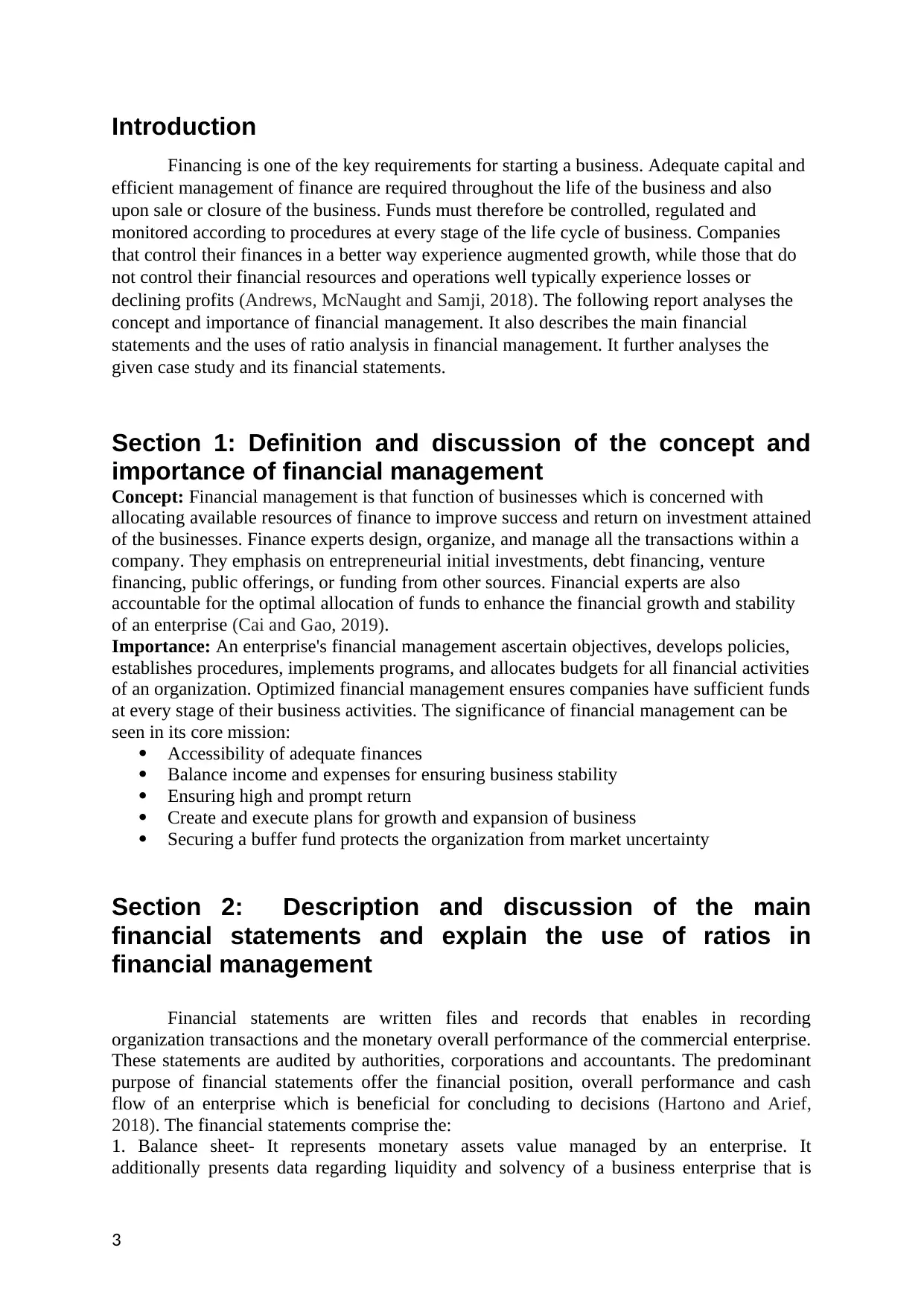
Introduction
Financing is one of the key requirements for starting a business. Adequate capital and
efficient management of finance are required throughout the life of the business and also
upon sale or closure of the business. Funds must therefore be controlled, regulated and
monitored according to procedures at every stage of the life cycle of business. Companies
that control their finances in a better way experience augmented growth, while those that do
not control their financial resources and operations well typically experience losses or
declining profits (Andrews, McNaught and Samji, 2018). The following report analyses the
concept and importance of financial management. It also describes the main financial
statements and the uses of ratio analysis in financial management. It further analyses the
given case study and its financial statements.
Section 1: Definition and discussion of the concept and
importance of financial management
Concept: Financial management is that function of businesses which is concerned with
allocating available resources of finance to improve success and return on investment attained
of the businesses. Finance experts design, organize, and manage all the transactions within a
company. They emphasis on entrepreneurial initial investments, debt financing, venture
financing, public offerings, or funding from other sources. Financial experts are also
accountable for the optimal allocation of funds to enhance the financial growth and stability
of an enterprise (Cai and Gao, 2019).
Importance: An enterprise's financial management ascertain objectives, develops policies,
establishes procedures, implements programs, and allocates budgets for all financial activities
of an organization. Optimized financial management ensures companies have sufficient funds
at every stage of their business activities. The significance of financial management can be
seen in its core mission:
Accessibility of adequate finances
Balance income and expenses for ensuring business stability
Ensuring high and prompt return
Create and execute plans for growth and expansion of business
Securing a buffer fund protects the organization from market uncertainty
Section 2: Description and discussion of the main
financial statements and explain the use of ratios in
financial management
Financial statements are written files and records that enables in recording
organization transactions and the monetary overall performance of the commercial enterprise.
These statements are audited by authorities, corporations and accountants. The predominant
purpose of financial statements offer the financial position, overall performance and cash
flow of an enterprise which is beneficial for concluding to decisions (Hartono and Arief,
2018). The financial statements comprise the:
1. Balance sheet- It represents monetary assets value managed by an enterprise. It
additionally presents data regarding liquidity and solvency of a business enterprise that is
3
Financing is one of the key requirements for starting a business. Adequate capital and
efficient management of finance are required throughout the life of the business and also
upon sale or closure of the business. Funds must therefore be controlled, regulated and
monitored according to procedures at every stage of the life cycle of business. Companies
that control their finances in a better way experience augmented growth, while those that do
not control their financial resources and operations well typically experience losses or
declining profits (Andrews, McNaught and Samji, 2018). The following report analyses the
concept and importance of financial management. It also describes the main financial
statements and the uses of ratio analysis in financial management. It further analyses the
given case study and its financial statements.
Section 1: Definition and discussion of the concept and
importance of financial management
Concept: Financial management is that function of businesses which is concerned with
allocating available resources of finance to improve success and return on investment attained
of the businesses. Finance experts design, organize, and manage all the transactions within a
company. They emphasis on entrepreneurial initial investments, debt financing, venture
financing, public offerings, or funding from other sources. Financial experts are also
accountable for the optimal allocation of funds to enhance the financial growth and stability
of an enterprise (Cai and Gao, 2019).
Importance: An enterprise's financial management ascertain objectives, develops policies,
establishes procedures, implements programs, and allocates budgets for all financial activities
of an organization. Optimized financial management ensures companies have sufficient funds
at every stage of their business activities. The significance of financial management can be
seen in its core mission:
Accessibility of adequate finances
Balance income and expenses for ensuring business stability
Ensuring high and prompt return
Create and execute plans for growth and expansion of business
Securing a buffer fund protects the organization from market uncertainty
Section 2: Description and discussion of the main
financial statements and explain the use of ratios in
financial management
Financial statements are written files and records that enables in recording
organization transactions and the monetary overall performance of the commercial enterprise.
These statements are audited by authorities, corporations and accountants. The predominant
purpose of financial statements offer the financial position, overall performance and cash
flow of an enterprise which is beneficial for concluding to decisions (Hartono and Arief,
2018). The financial statements comprise the:
1. Balance sheet- It represents monetary assets value managed by an enterprise. It
additionally presents data regarding liquidity and solvency of a business enterprise that is
3
⊘ This is a preview!⊘
Do you want full access?
Subscribe today to unlock all pages.

Trusted by 1+ million students worldwide
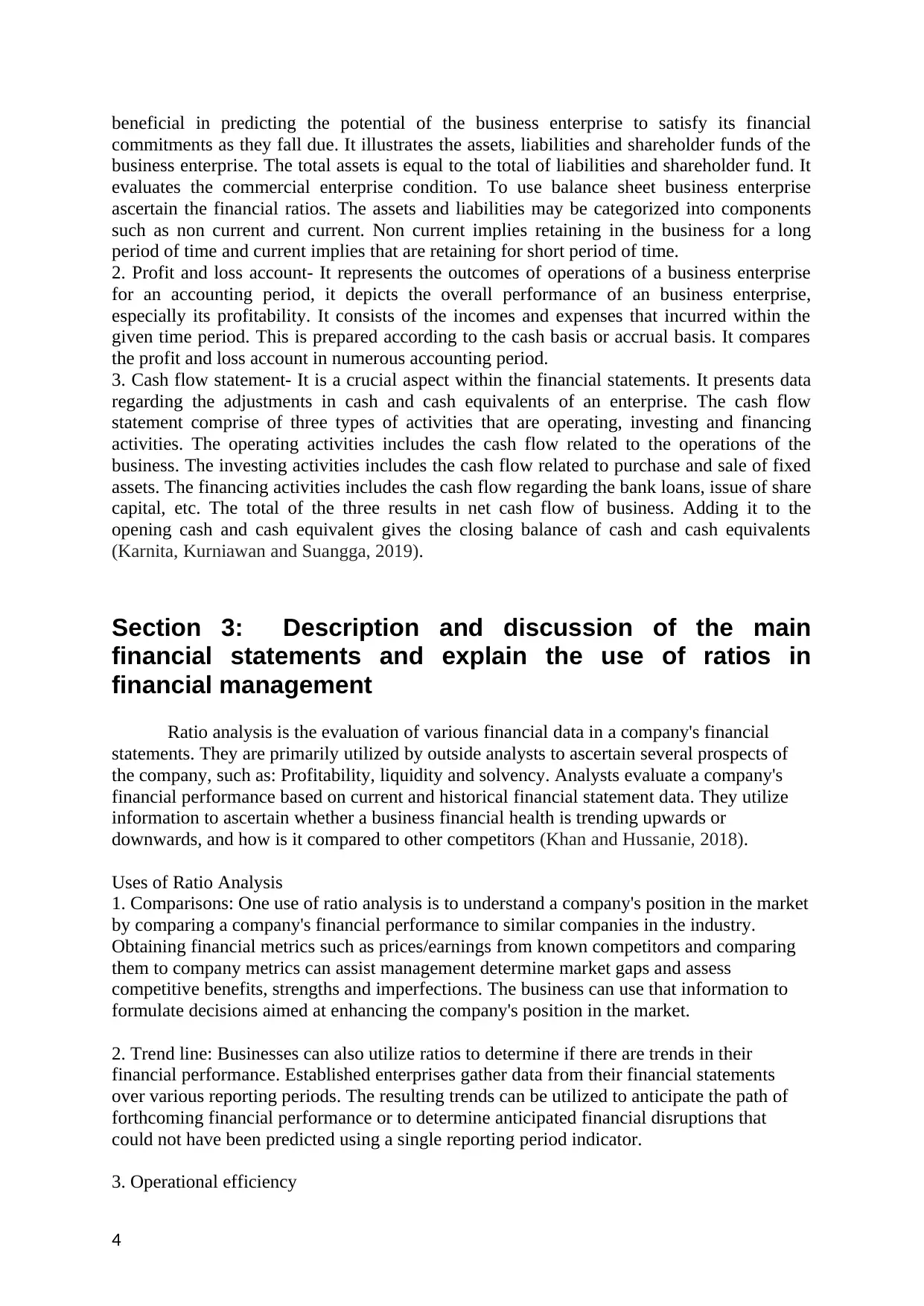
beneficial in predicting the potential of the business enterprise to satisfy its financial
commitments as they fall due. It illustrates the assets, liabilities and shareholder funds of the
business enterprise. The total assets is equal to the total of liabilities and shareholder fund. It
evaluates the commercial enterprise condition. To use balance sheet business enterprise
ascertain the financial ratios. The assets and liabilities may be categorized into components
such as non current and current. Non current implies retaining in the business for a long
period of time and current implies that are retaining for short period of time.
2. Profit and loss account- It represents the outcomes of operations of a business enterprise
for an accounting period, it depicts the overall performance of an business enterprise,
especially its profitability. It consists of the incomes and expenses that incurred within the
given time period. This is prepared according to the cash basis or accrual basis. It compares
the profit and loss account in numerous accounting period.
3. Cash flow statement- It is a crucial aspect within the financial statements. It presents data
regarding the adjustments in cash and cash equivalents of an enterprise. The cash flow
statement comprise of three types of activities that are operating, investing and financing
activities. The operating activities includes the cash flow related to the operations of the
business. The investing activities includes the cash flow related to purchase and sale of fixed
assets. The financing activities includes the cash flow regarding the bank loans, issue of share
capital, etc. The total of the three results in net cash flow of business. Adding it to the
opening cash and cash equivalent gives the closing balance of cash and cash equivalents
(Karnita, Kurniawan and Suangga, 2019).
Section 3: Description and discussion of the main
financial statements and explain the use of ratios in
financial management
Ratio analysis is the evaluation of various financial data in a company's financial
statements. They are primarily utilized by outside analysts to ascertain several prospects of
the company, such as: Profitability, liquidity and solvency. Analysts evaluate a company's
financial performance based on current and historical financial statement data. They utilize
information to ascertain whether a business financial health is trending upwards or
downwards, and how is it compared to other competitors (Khan and Hussanie, 2018).
Uses of Ratio Analysis
1. Comparisons: One use of ratio analysis is to understand a company's position in the market
by comparing a company's financial performance to similar companies in the industry.
Obtaining financial metrics such as prices/earnings from known competitors and comparing
them to company metrics can assist management determine market gaps and assess
competitive benefits, strengths and imperfections. The business can use that information to
formulate decisions aimed at enhancing the company's position in the market.
2. Trend line: Businesses can also utilize ratios to determine if there are trends in their
financial performance. Established enterprises gather data from their financial statements
over various reporting periods. The resulting trends can be utilized to anticipate the path of
forthcoming financial performance or to determine anticipated financial disruptions that
could not have been predicted using a single reporting period indicator.
3. Operational efficiency
4
commitments as they fall due. It illustrates the assets, liabilities and shareholder funds of the
business enterprise. The total assets is equal to the total of liabilities and shareholder fund. It
evaluates the commercial enterprise condition. To use balance sheet business enterprise
ascertain the financial ratios. The assets and liabilities may be categorized into components
such as non current and current. Non current implies retaining in the business for a long
period of time and current implies that are retaining for short period of time.
2. Profit and loss account- It represents the outcomes of operations of a business enterprise
for an accounting period, it depicts the overall performance of an business enterprise,
especially its profitability. It consists of the incomes and expenses that incurred within the
given time period. This is prepared according to the cash basis or accrual basis. It compares
the profit and loss account in numerous accounting period.
3. Cash flow statement- It is a crucial aspect within the financial statements. It presents data
regarding the adjustments in cash and cash equivalents of an enterprise. The cash flow
statement comprise of three types of activities that are operating, investing and financing
activities. The operating activities includes the cash flow related to the operations of the
business. The investing activities includes the cash flow related to purchase and sale of fixed
assets. The financing activities includes the cash flow regarding the bank loans, issue of share
capital, etc. The total of the three results in net cash flow of business. Adding it to the
opening cash and cash equivalent gives the closing balance of cash and cash equivalents
(Karnita, Kurniawan and Suangga, 2019).
Section 3: Description and discussion of the main
financial statements and explain the use of ratios in
financial management
Ratio analysis is the evaluation of various financial data in a company's financial
statements. They are primarily utilized by outside analysts to ascertain several prospects of
the company, such as: Profitability, liquidity and solvency. Analysts evaluate a company's
financial performance based on current and historical financial statement data. They utilize
information to ascertain whether a business financial health is trending upwards or
downwards, and how is it compared to other competitors (Khan and Hussanie, 2018).
Uses of Ratio Analysis
1. Comparisons: One use of ratio analysis is to understand a company's position in the market
by comparing a company's financial performance to similar companies in the industry.
Obtaining financial metrics such as prices/earnings from known competitors and comparing
them to company metrics can assist management determine market gaps and assess
competitive benefits, strengths and imperfections. The business can use that information to
formulate decisions aimed at enhancing the company's position in the market.
2. Trend line: Businesses can also utilize ratios to determine if there are trends in their
financial performance. Established enterprises gather data from their financial statements
over various reporting periods. The resulting trends can be utilized to anticipate the path of
forthcoming financial performance or to determine anticipated financial disruptions that
could not have been predicted using a single reporting period indicator.
3. Operational efficiency
4
Paraphrase This Document
Need a fresh take? Get an instant paraphrase of this document with our AI Paraphraser
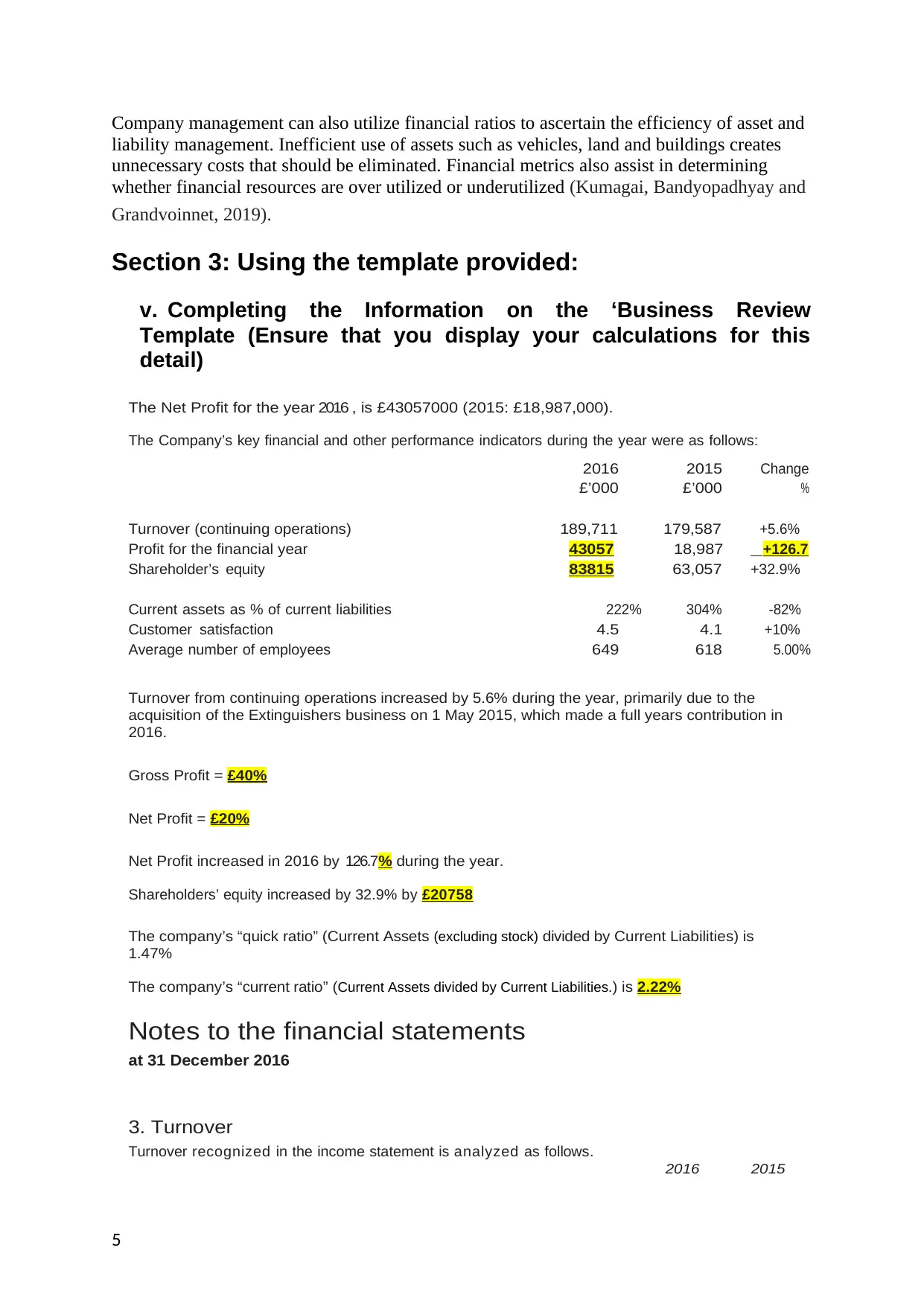
Company management can also utilize financial ratios to ascertain the efficiency of asset and
liability management. Inefficient use of assets such as vehicles, land and buildings creates
unnecessary costs that should be eliminated. Financial metrics also assist in determining
whether financial resources are over utilized or underutilized (Kumagai, Bandyopadhyay and
Grandvoinnet, 2019).
Section 3: Using the template provided:
v. Completing the Information on the ‘Business Review
Template (Ensure that you display your calculations for this
detail)
The Net Profit for the year 2016 , is £43057000 (2015: £18,987,000).
The Company’s key financial and other performance indicators during the year were as follows:
2016
£’000
2015
£’000
Change
%
Turnover (continuing operations) 189,711 179,587 +5.6%
Profit for the financial year 43057 18,987 +126.7
Shareholder’s equity 83815 63,057 +32.9%
Current assets as % of current liabilities 222% 304% -82%
Customer satisfaction 4.5 4.1 +10%
Average number of employees 649 618 5.00%
Turnover from continuing operations increased by 5.6% during the year, primarily due to the
acquisition of the Extinguishers business on 1 May 2015, which made a full years contribution in
2016.
Gross Profit = £40%
Net Profit = £20%
Net Profit increased in 2016 by 126.7% during the year.
Shareholders’ equity increased by 32.9% by £20758
The company’s “quick ratio” (Current Assets (excluding stock) divided by Current Liabilities) is
1.47%
The company’s “current ratio” (Current Assets divided by Current Liabilities. ) is 2.22%
Notes to the financial statements
at 31 December 2016
3. Turnover
Turnover recognized in the income statement is analyzed as follows.
2016 2015
5
liability management. Inefficient use of assets such as vehicles, land and buildings creates
unnecessary costs that should be eliminated. Financial metrics also assist in determining
whether financial resources are over utilized or underutilized (Kumagai, Bandyopadhyay and
Grandvoinnet, 2019).
Section 3: Using the template provided:
v. Completing the Information on the ‘Business Review
Template (Ensure that you display your calculations for this
detail)
The Net Profit for the year 2016 , is £43057000 (2015: £18,987,000).
The Company’s key financial and other performance indicators during the year were as follows:
2016
£’000
2015
£’000
Change
%
Turnover (continuing operations) 189,711 179,587 +5.6%
Profit for the financial year 43057 18,987 +126.7
Shareholder’s equity 83815 63,057 +32.9%
Current assets as % of current liabilities 222% 304% -82%
Customer satisfaction 4.5 4.1 +10%
Average number of employees 649 618 5.00%
Turnover from continuing operations increased by 5.6% during the year, primarily due to the
acquisition of the Extinguishers business on 1 May 2015, which made a full years contribution in
2016.
Gross Profit = £40%
Net Profit = £20%
Net Profit increased in 2016 by 126.7% during the year.
Shareholders’ equity increased by 32.9% by £20758
The company’s “quick ratio” (Current Assets (excluding stock) divided by Current Liabilities) is
1.47%
The company’s “current ratio” (Current Assets divided by Current Liabilities. ) is 2.22%
Notes to the financial statements
at 31 December 2016
3. Turnover
Turnover recognized in the income statement is analyzed as follows.
2016 2015
5
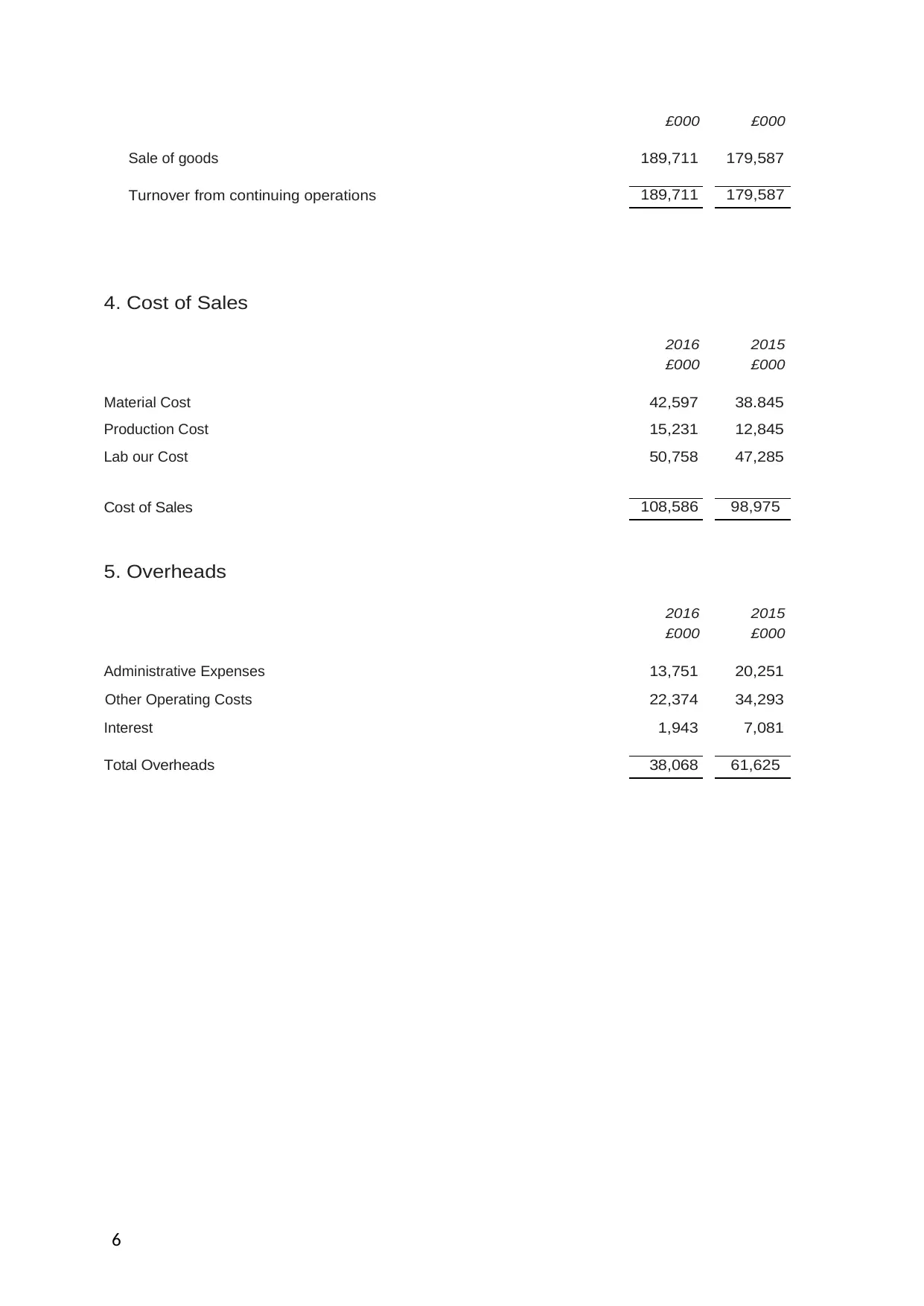
£000 £000
Sale of goods 189,711 179,587
Turnover from continuing operations 189,711 179,587
4. Cost of Sales
2016 2015
£000 £000
Material Cost 42,597 38.845
Production Cost 15,231 12,845
Lab our Cost 50,758 47,285
Cost of Sales 108,586 98,975
5. Overheads
2016 2015
£000 £000
Administrative Expenses 13,751 20,251
Other Operating Costs 22,374 34,293
Interest 1,943 7,081
Total Overheads 38,068 61,625
6
Sale of goods 189,711 179,587
Turnover from continuing operations 189,711 179,587
4. Cost of Sales
2016 2015
£000 £000
Material Cost 42,597 38.845
Production Cost 15,231 12,845
Lab our Cost 50,758 47,285
Cost of Sales 108,586 98,975
5. Overheads
2016 2015
£000 £000
Administrative Expenses 13,751 20,251
Other Operating Costs 22,374 34,293
Interest 1,943 7,081
Total Overheads 38,068 61,625
6
⊘ This is a preview!⊘
Do you want full access?
Subscribe today to unlock all pages.

Trusted by 1+ million students worldwide
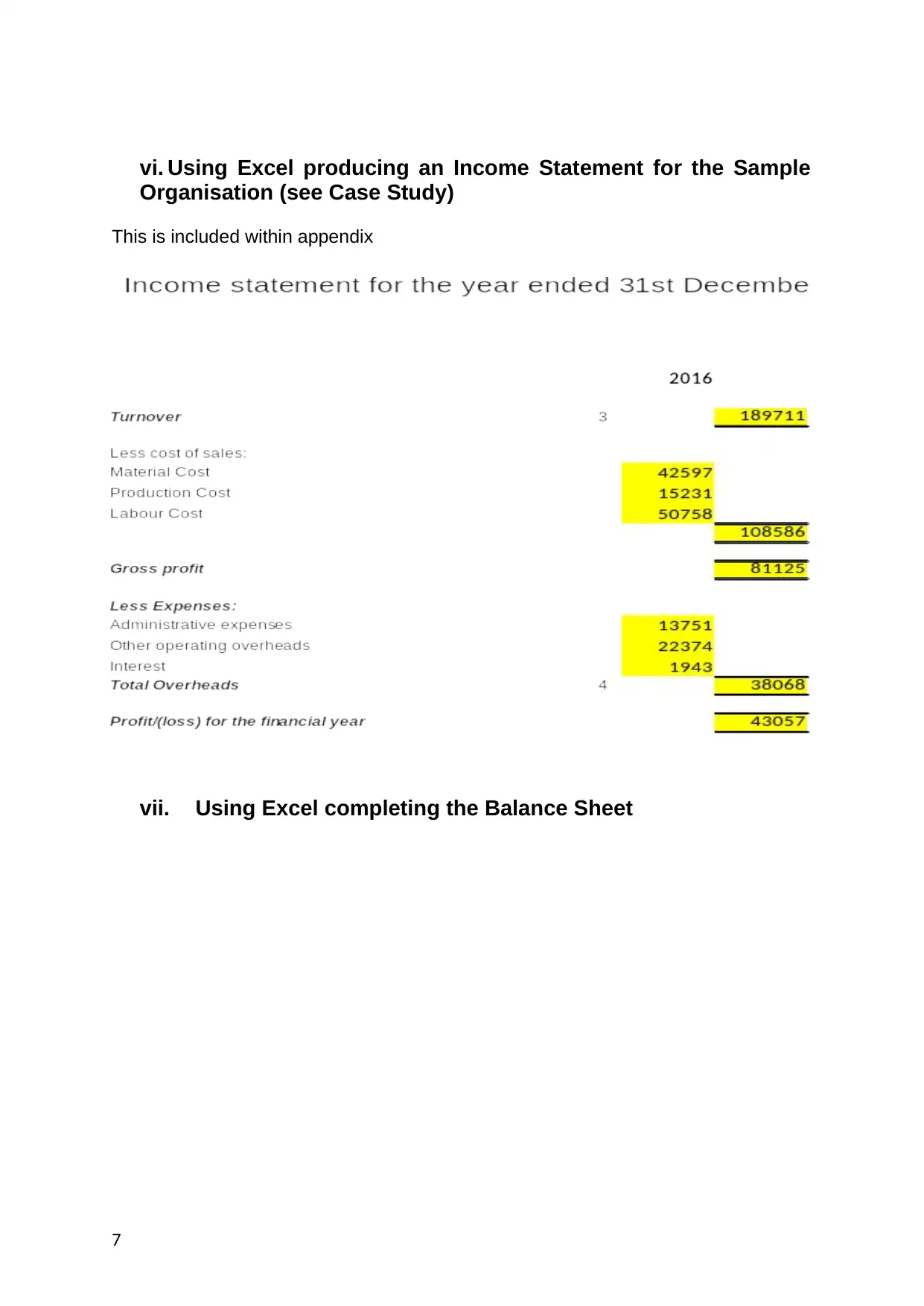
vi. Using Excel producing an Income Statement for the Sample
Organisation (see Case Study)
This is included within appendix
vii. Using Excel completing the Balance Sheet
7
Organisation (see Case Study)
This is included within appendix
vii. Using Excel completing the Balance Sheet
7
Paraphrase This Document
Need a fresh take? Get an instant paraphrase of this document with our AI Paraphraser
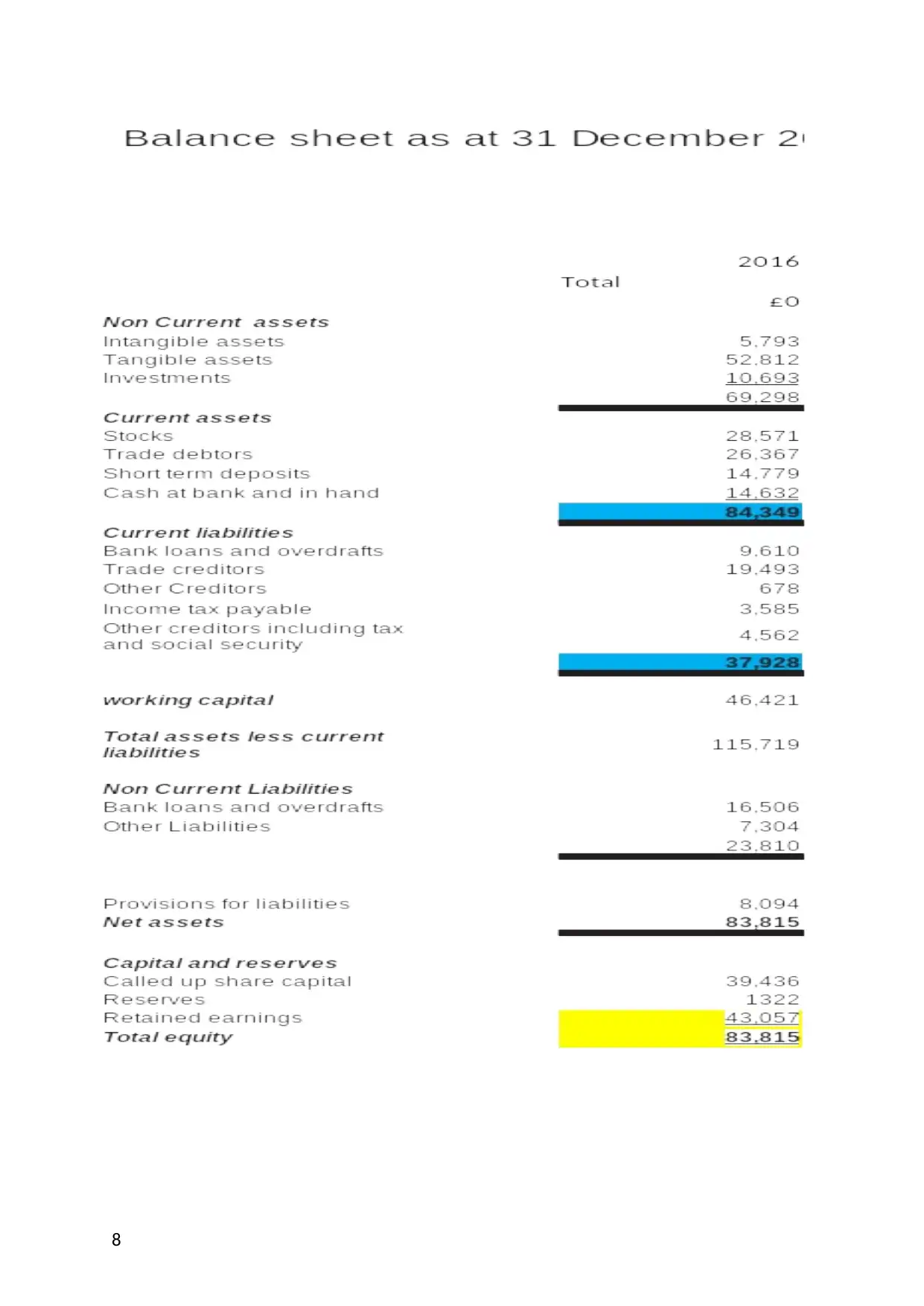
8
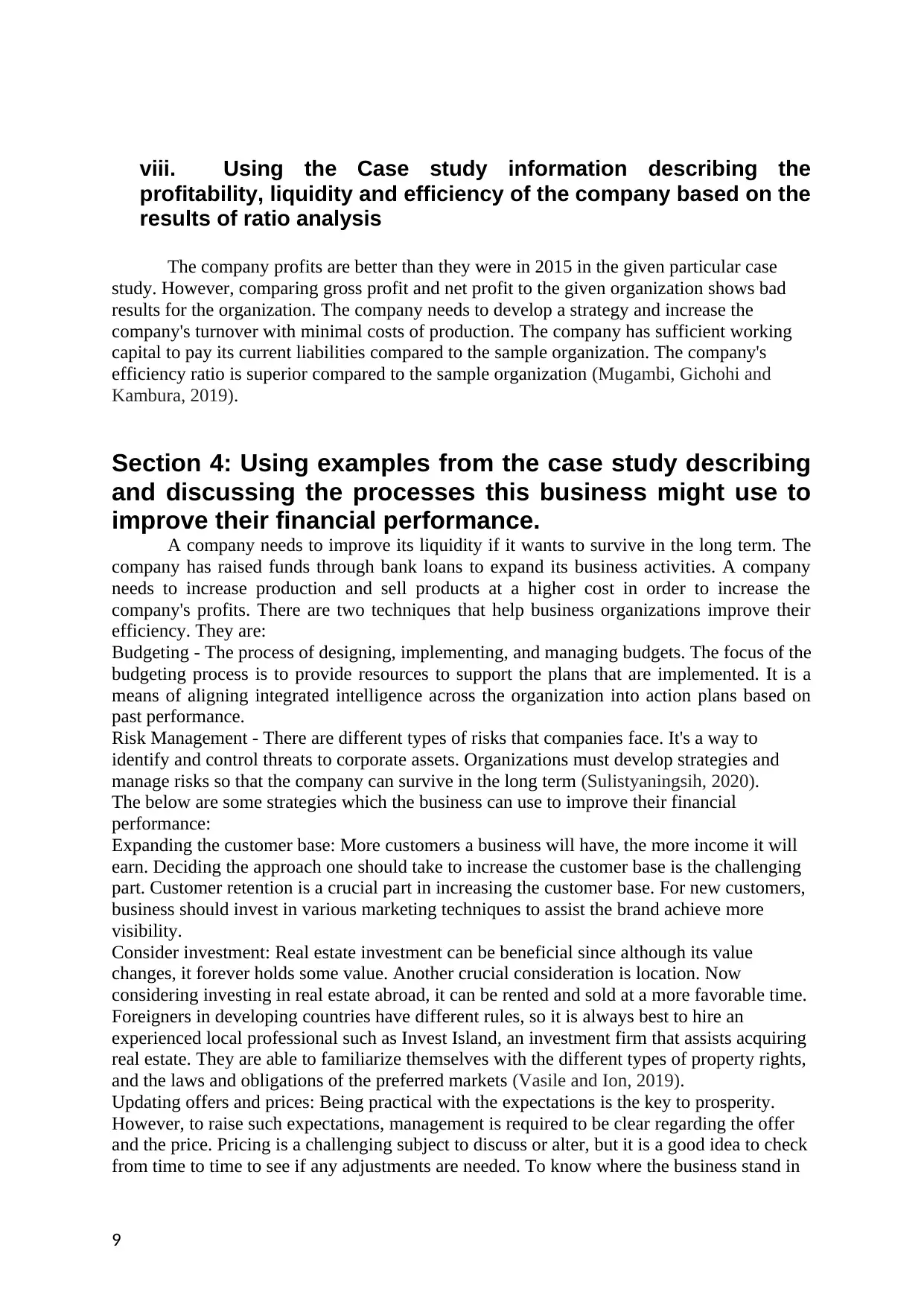
viii. Using the Case study information describing the
profitability, liquidity and efficiency of the company based on the
results of ratio analysis
The company profits are better than they were in 2015 in the given particular case
study. However, comparing gross profit and net profit to the given organization shows bad
results for the organization. The company needs to develop a strategy and increase the
company's turnover with minimal costs of production. The company has sufficient working
capital to pay its current liabilities compared to the sample organization. The company's
efficiency ratio is superior compared to the sample organization (Mugambi, Gichohi and
Kambura, 2019).
Section 4: Using examples from the case study describing
and discussing the processes this business might use to
improve their financial performance.
A company needs to improve its liquidity if it wants to survive in the long term. The
company has raised funds through bank loans to expand its business activities. A company
needs to increase production and sell products at a higher cost in order to increase the
company's profits. There are two techniques that help business organizations improve their
efficiency. They are:
Budgeting - The process of designing, implementing, and managing budgets. The focus of the
budgeting process is to provide resources to support the plans that are implemented. It is a
means of aligning integrated intelligence across the organization into action plans based on
past performance.
Risk Management - There are different types of risks that companies face. It's a way to
identify and control threats to corporate assets. Organizations must develop strategies and
manage risks so that the company can survive in the long term (Sulistyaningsih, 2020).
The below are some strategies which the business can use to improve their financial
performance:
Expanding the customer base: More customers a business will have, the more income it will
earn. Deciding the approach one should take to increase the customer base is the challenging
part. Customer retention is a crucial part in increasing the customer base. For new customers,
business should invest in various marketing techniques to assist the brand achieve more
visibility.
Consider investment: Real estate investment can be beneficial since although its value
changes, it forever holds some value. Another crucial consideration is location. Now
considering investing in real estate abroad, it can be rented and sold at a more favorable time.
Foreigners in developing countries have different rules, so it is always best to hire an
experienced local professional such as Invest Island, an investment firm that assists acquiring
real estate. They are able to familiarize themselves with the different types of property rights,
and the laws and obligations of the preferred markets (Vasile and Ion, 2019).
Updating offers and prices: Being practical with the expectations is the key to prosperity.
However, to raise such expectations, management is required to be clear regarding the offer
and the price. Pricing is a challenging subject to discuss or alter, but it is a good idea to check
from time to time to see if any adjustments are needed. To know where the business stand in
9
profitability, liquidity and efficiency of the company based on the
results of ratio analysis
The company profits are better than they were in 2015 in the given particular case
study. However, comparing gross profit and net profit to the given organization shows bad
results for the organization. The company needs to develop a strategy and increase the
company's turnover with minimal costs of production. The company has sufficient working
capital to pay its current liabilities compared to the sample organization. The company's
efficiency ratio is superior compared to the sample organization (Mugambi, Gichohi and
Kambura, 2019).
Section 4: Using examples from the case study describing
and discussing the processes this business might use to
improve their financial performance.
A company needs to improve its liquidity if it wants to survive in the long term. The
company has raised funds through bank loans to expand its business activities. A company
needs to increase production and sell products at a higher cost in order to increase the
company's profits. There are two techniques that help business organizations improve their
efficiency. They are:
Budgeting - The process of designing, implementing, and managing budgets. The focus of the
budgeting process is to provide resources to support the plans that are implemented. It is a
means of aligning integrated intelligence across the organization into action plans based on
past performance.
Risk Management - There are different types of risks that companies face. It's a way to
identify and control threats to corporate assets. Organizations must develop strategies and
manage risks so that the company can survive in the long term (Sulistyaningsih, 2020).
The below are some strategies which the business can use to improve their financial
performance:
Expanding the customer base: More customers a business will have, the more income it will
earn. Deciding the approach one should take to increase the customer base is the challenging
part. Customer retention is a crucial part in increasing the customer base. For new customers,
business should invest in various marketing techniques to assist the brand achieve more
visibility.
Consider investment: Real estate investment can be beneficial since although its value
changes, it forever holds some value. Another crucial consideration is location. Now
considering investing in real estate abroad, it can be rented and sold at a more favorable time.
Foreigners in developing countries have different rules, so it is always best to hire an
experienced local professional such as Invest Island, an investment firm that assists acquiring
real estate. They are able to familiarize themselves with the different types of property rights,
and the laws and obligations of the preferred markets (Vasile and Ion, 2019).
Updating offers and prices: Being practical with the expectations is the key to prosperity.
However, to raise such expectations, management is required to be clear regarding the offer
and the price. Pricing is a challenging subject to discuss or alter, but it is a good idea to check
from time to time to see if any adjustments are needed. To know where the business stand in
9
⊘ This is a preview!⊘
Do you want full access?
Subscribe today to unlock all pages.

Trusted by 1+ million students worldwide
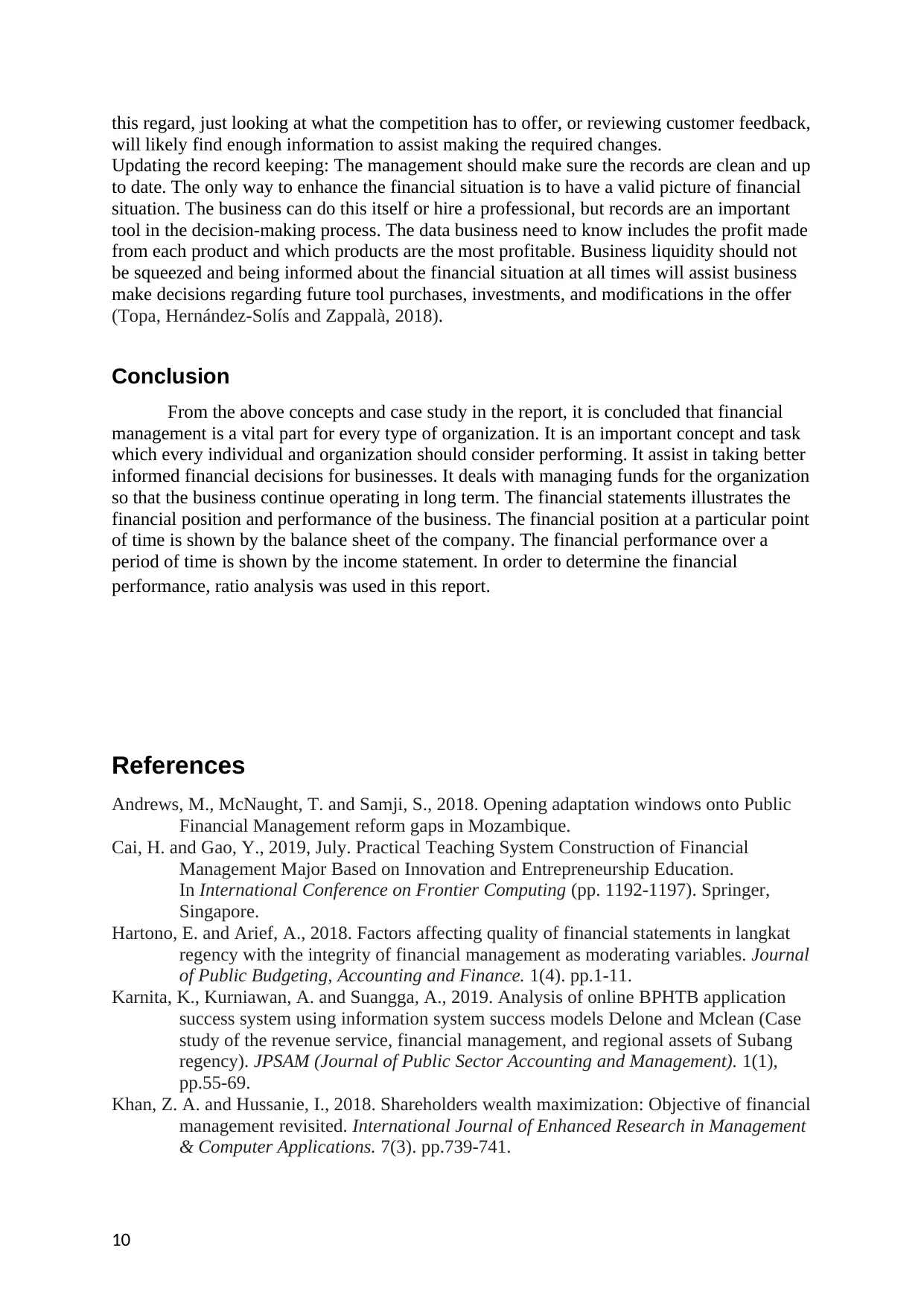
this regard, just looking at what the competition has to offer, or reviewing customer feedback,
will likely find enough information to assist making the required changes.
Updating the record keeping: The management should make sure the records are clean and up
to date. The only way to enhance the financial situation is to have a valid picture of financial
situation. The business can do this itself or hire a professional, but records are an important
tool in the decision-making process. The data business need to know includes the profit made
from each product and which products are the most profitable. Business liquidity should not
be squeezed and being informed about the financial situation at all times will assist business
make decisions regarding future tool purchases, investments, and modifications in the offer
(Topa, Hernández-Solís and Zappalà, 2018).
Conclusion
From the above concepts and case study in the report, it is concluded that financial
management is a vital part for every type of organization. It is an important concept and task
which every individual and organization should consider performing. It assist in taking better
informed financial decisions for businesses. It deals with managing funds for the organization
so that the business continue operating in long term. The financial statements illustrates the
financial position and performance of the business. The financial position at a particular point
of time is shown by the balance sheet of the company. The financial performance over a
period of time is shown by the income statement. In order to determine the financial
performance, ratio analysis was used in this report.
References
Andrews, M., McNaught, T. and Samji, S., 2018. Opening adaptation windows onto Public
Financial Management reform gaps in Mozambique.
Cai, H. and Gao, Y., 2019, July. Practical Teaching System Construction of Financial
Management Major Based on Innovation and Entrepreneurship Education.
In International Conference on Frontier Computing (pp. 1192-1197). Springer,
Singapore.
Hartono, E. and Arief, A., 2018. Factors affecting quality of financial statements in langkat
regency with the integrity of financial management as moderating variables. Journal
of Public Budgeting, Accounting and Finance. 1(4). pp.1-11.
Karnita, K., Kurniawan, A. and Suangga, A., 2019. Analysis of online BPHTB application
success system using information system success models Delone and Mclean (Case
study of the revenue service, financial management, and regional assets of Subang
regency). JPSAM (Journal of Public Sector Accounting and Management). 1(1),
pp.55-69.
Khan, Z. A. and Hussanie, I., 2018. Shareholders wealth maximization: Objective of financial
management revisited. International Journal of Enhanced Research in Management
& Computer Applications. 7(3). pp.739-741.
10
will likely find enough information to assist making the required changes.
Updating the record keeping: The management should make sure the records are clean and up
to date. The only way to enhance the financial situation is to have a valid picture of financial
situation. The business can do this itself or hire a professional, but records are an important
tool in the decision-making process. The data business need to know includes the profit made
from each product and which products are the most profitable. Business liquidity should not
be squeezed and being informed about the financial situation at all times will assist business
make decisions regarding future tool purchases, investments, and modifications in the offer
(Topa, Hernández-Solís and Zappalà, 2018).
Conclusion
From the above concepts and case study in the report, it is concluded that financial
management is a vital part for every type of organization. It is an important concept and task
which every individual and organization should consider performing. It assist in taking better
informed financial decisions for businesses. It deals with managing funds for the organization
so that the business continue operating in long term. The financial statements illustrates the
financial position and performance of the business. The financial position at a particular point
of time is shown by the balance sheet of the company. The financial performance over a
period of time is shown by the income statement. In order to determine the financial
performance, ratio analysis was used in this report.
References
Andrews, M., McNaught, T. and Samji, S., 2018. Opening adaptation windows onto Public
Financial Management reform gaps in Mozambique.
Cai, H. and Gao, Y., 2019, July. Practical Teaching System Construction of Financial
Management Major Based on Innovation and Entrepreneurship Education.
In International Conference on Frontier Computing (pp. 1192-1197). Springer,
Singapore.
Hartono, E. and Arief, A., 2018. Factors affecting quality of financial statements in langkat
regency with the integrity of financial management as moderating variables. Journal
of Public Budgeting, Accounting and Finance. 1(4). pp.1-11.
Karnita, K., Kurniawan, A. and Suangga, A., 2019. Analysis of online BPHTB application
success system using information system success models Delone and Mclean (Case
study of the revenue service, financial management, and regional assets of Subang
regency). JPSAM (Journal of Public Sector Accounting and Management). 1(1),
pp.55-69.
Khan, Z. A. and Hussanie, I., 2018. Shareholders wealth maximization: Objective of financial
management revisited. International Journal of Enhanced Research in Management
& Computer Applications. 7(3). pp.739-741.
10
Paraphrase This Document
Need a fresh take? Get an instant paraphrase of this document with our AI Paraphraser
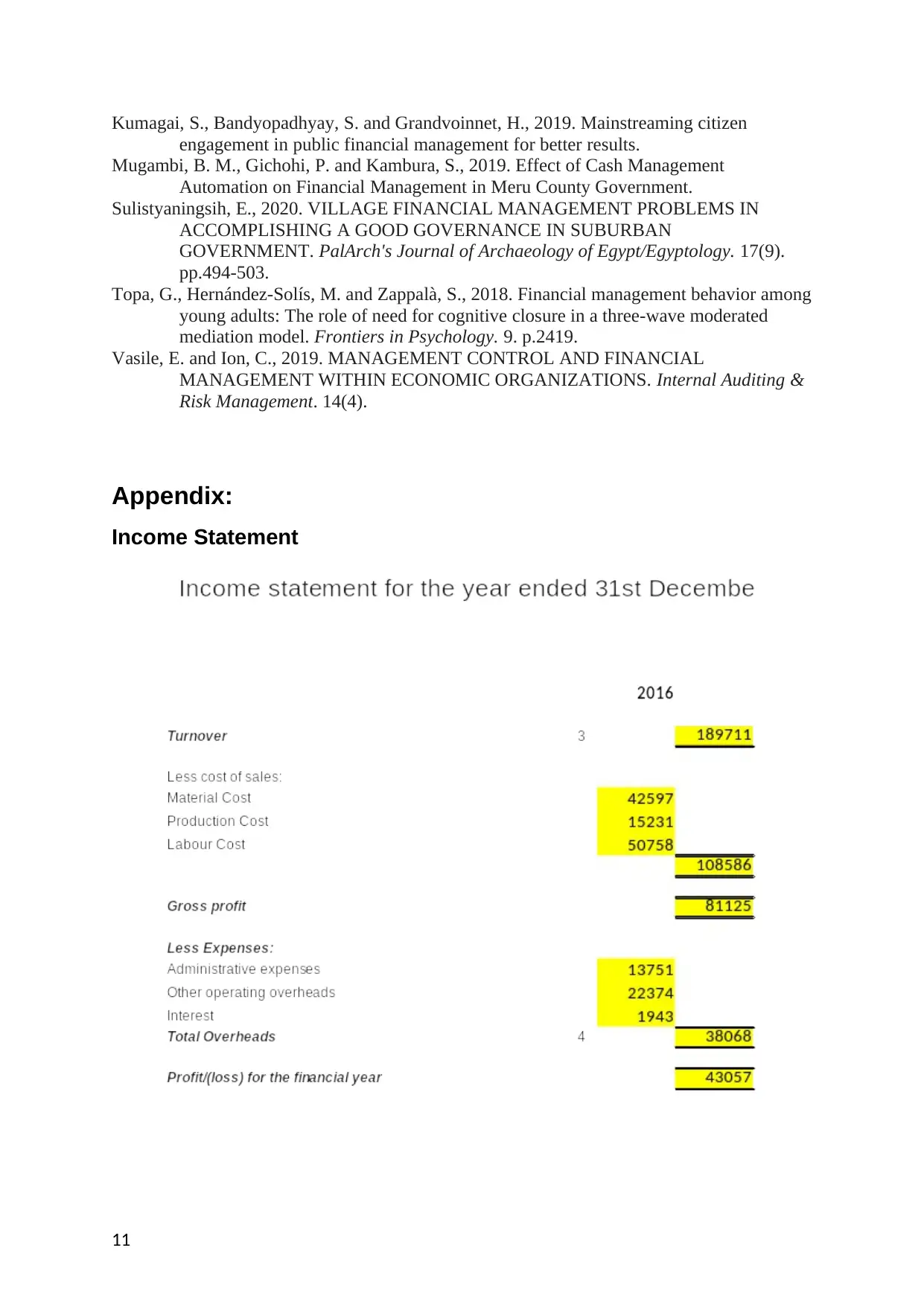
Kumagai, S., Bandyopadhyay, S. and Grandvoinnet, H., 2019. Mainstreaming citizen
engagement in public financial management for better results.
Mugambi, B. M., Gichohi, P. and Kambura, S., 2019. Effect of Cash Management
Automation on Financial Management in Meru County Government.
Sulistyaningsih, E., 2020. VILLAGE FINANCIAL MANAGEMENT PROBLEMS IN
ACCOMPLISHING A GOOD GOVERNANCE IN SUBURBAN
GOVERNMENT. PalArch's Journal of Archaeology of Egypt/Egyptology. 17(9).
pp.494-503.
Topa, G., Hernández-Solís, M. and Zappalà, S., 2018. Financial management behavior among
young adults: The role of need for cognitive closure in a three-wave moderated
mediation model. Frontiers in Psychology. 9. p.2419.
Vasile, E. and Ion, C., 2019. MANAGEMENT CONTROL AND FINANCIAL
MANAGEMENT WITHIN ECONOMIC ORGANIZATIONS. Internal Auditing &
Risk Management. 14(4).
Appendix:
Income Statement
11
engagement in public financial management for better results.
Mugambi, B. M., Gichohi, P. and Kambura, S., 2019. Effect of Cash Management
Automation on Financial Management in Meru County Government.
Sulistyaningsih, E., 2020. VILLAGE FINANCIAL MANAGEMENT PROBLEMS IN
ACCOMPLISHING A GOOD GOVERNANCE IN SUBURBAN
GOVERNMENT. PalArch's Journal of Archaeology of Egypt/Egyptology. 17(9).
pp.494-503.
Topa, G., Hernández-Solís, M. and Zappalà, S., 2018. Financial management behavior among
young adults: The role of need for cognitive closure in a three-wave moderated
mediation model. Frontiers in Psychology. 9. p.2419.
Vasile, E. and Ion, C., 2019. MANAGEMENT CONTROL AND FINANCIAL
MANAGEMENT WITHIN ECONOMIC ORGANIZATIONS. Internal Auditing &
Risk Management. 14(4).
Appendix:
Income Statement
11
1 out of 11
Related Documents
Your All-in-One AI-Powered Toolkit for Academic Success.
+13062052269
info@desklib.com
Available 24*7 on WhatsApp / Email
![[object Object]](/_next/static/media/star-bottom.7253800d.svg)
Unlock your academic potential
Copyright © 2020–2025 A2Z Services. All Rights Reserved. Developed and managed by ZUCOL.



